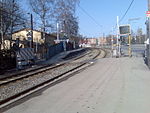Rikshospitalet tram stop
1999 establishments in NorwayNorway tram stubsOslo Metro stubsOslo Tramway stations in OsloRailway stations opened in 1999

Rikshospitalet is a light rail tram stop at the end of the Ullevål Hageby Line of the Oslo Tramway. It is located at Rikshospitalet, the Norwegian National Hospital, at Gaustad in Oslo, Norway. The station opened on 1 June, 1999 as part of the line extension when the hospital opened. The expansion was financed by Oslo Package 2. The station is served by lines 17 and 18, using SL95 low-floor trams. This allows step-free access from and to all stations until the city center. Trams operate each five minutes. The next station is Gaustadalléen. In the past, line 10 which ran from Rikshospitalet to Jar, used to operate here.
Excerpt from the Wikipedia article Rikshospitalet tram stop (License: CC BY-SA 3.0, Authors, Images).Rikshospitalet tram stop
Sognsvannsveien, Oslo Gaustad
Geographical coordinates (GPS) Address Nearby Places Show on map
Geographical coordinates (GPS)
| Latitude | Longitude |
|---|---|
| N 59.947768 ° | E 10.714716 ° |
Address
Rikshospitalet
Sognsvannsveien
0349 Oslo, Gaustad
Norway
Open on Google Maps









